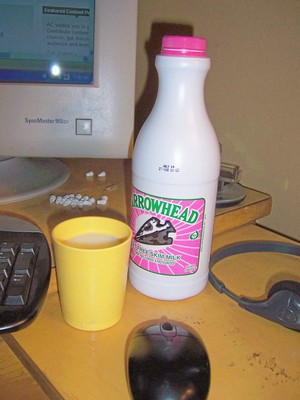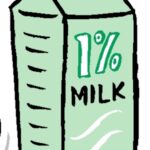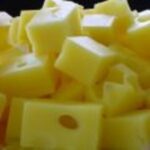In a time of increasing prices, when a gallon of gasoline costs almost as much as a gallon of liquid milk, parents have to make tough decisions. Everyone in the family needs to consume dairy products each day for part of their Vitamin D and calcium nutritional requirements. Milk is one of the best ways that a person who is not allergic or lactose intolerant can at least partially meet this requirement. But should the shopper choose liquid milk or instant nonfat dry milk to do this? Let’s examine the advantages and disadvantages of using either form.
Convenience of Use
Liquid milk is convenient because it is already in liquid form. No mixing or leaving a mess of powder granules anywhere. It is instantly cold from the refrigerator if not left out on the counter for too long. Liquid milk comes in a storable container and can be purchased in pints, quarts, half gallons, and gallons.
Nonfat dry milk must be reconstituted with water which requires a little preparation time especially if the individual wants to drink cold milk. Sometimes in the measuring and mixing, milk powder granules can spill over the measuring cup and create a mess. The individual must supply his own pitcher or container for the milk. If water directly from the tap is added to the milk powder in a pitcher, the milk will foam quite a bit. It is best to put the desired amount of water in the pitcher and then add the powder using a wire whisk to dissolve the milk granules. Dry milk can be reconstituted by the cup, pint, quart, half gallon, and gallon. Additional dry milk granules can be added to allow for personal taste.
Comparing the Labels
When I compared the ingredient list and Nutrition Facts label on a bottle of Arrowhead skim milk, a box of Carnation Instant Nonfat Dry Milk, and a box of Flavorite Instant Nonfat Dry Milk, I found very little difference. All three had added Vitamin A palmitate and Vitamin D3 to the milk. All stated there were no fat grams, less than 5 milligrams of cholesterol, and 12 grams of sugars. While the liquid milk label stated that there were 130 milligrams of sodium and 420 milligrams of potassium per serving, the Carnation dry milk label showed 125 milligrams of sodium and 390 grams of potassium in one reconstituted serving. The Flavorite dry milk did not list potassium but was the same as the Carnation in most other respects. The liquid milk had one more gram of protein than either brand of reconstituted dry milk. As far as the recommended dietary allowances, a cup of both liquid and dry milk supplied 30 per cent of the calcium and 25 per cent of the Vitamin D for a person on a 2,000 calorie diet. The liquid milk and dry milk both supplied 10 per cent or less of the Vitamin A and Vitamin C for that same caloric daily intake. The label on the Carnation dry milk indicated that one reconstituted cup supplied 25 per cent of the riboflavin, 15 per cent of the Vitamin B12, and 20 per cent of the phosphorus required by that person with the 2,000 calorie intake as well as less than 10 percent of the needed thiamin, Vitamin B6, pantothenic acid, and magnesium.
Comparing the Cost
A local warehouse store sells a 4.4 pound carton of Carnation Instant Nonfat Dry Milk, which makes 5 and one half gallons of milk, for $13.66. That equals about $2.48 per gallon of reconstituted milk. The local grocery store sells Flavorite Dry Milk for $12.99. The Flavorite Dry Milk comes in a 4 pound box which makes 20 quarts or 5 gallons of reconstituted milk. That equals about $2.59 per gallon. The liquid skim milk was $3.99 per gallon at the grocery store and $3.08 at the warehouse store.
Shelf (Refrigerator) Life
When purchasing liquid milk at the grocery store, the shopper should always check the expiration dates for the date farthest in the future. I have sometimes found a difference of two or three days between gallons of liquid milk in the store. I have also brought a carton of milk home only to find it was slightly past the expiration date and had soured on the grocery shelf. A good rule to use when getting liquid milk from the shelves is to check the rear of the shelf first. Many times the stocker will refill the shelf from behind the refrigerated dairy case and push the older milk toward the front of the shelf. Because the milk is already in liquid form, care must be taken to use the milk up before it sours in the refrigerator. For a family of milk-lovers, this would not be a problem. For others who drink milk only because it is good for them, it might be.
Dry milk may be reconstituted in as large a portion as needed. If a pitcher of reconstituted dry milk stays in the refrigerator too long, it too will sour in time. The pitcher the dry milk is reconstituted in must be kept clean and should be covered so as to prevent refrigerator odors from giving the milk a bad taste. Dry milk has a fairly long shelf life. The box of Flavorite Instant Nonfat Dry Milk had a “Sell By” date of April 1, 2009, and we purchased it almost a year before the expiration date. The box must be kept in a dry place away from any heat to keep the milk granules in optimal condition. Due to the longer shelf life, food-buying clubs and wholesale markets will sometimes have dry milk available in larger amounts than found in the grocery store.
Taste
This is where liquid and dry milk can differ. The Carnation Instant Nonfat Dry Milk seems smoother than the Flavorite Dry Milk which can have a little grittiness to its texture even when mixed well. Adding more dry milk can make the milk taste as rich as a person wants it and almost comparable to liquid milk. Sometimes when I get to the bottom of a pitcher of reconstituted dry milk there is a milky sediment which must be restirred into the liquid before use.
For the person who can not give up liquid milk entirely a compromise can be made by mixing half a pitcher of reconstituted dry milk to half a pitcher of liquid milk. I got this suggestion from WIC (Women, Infants, and Children nutrition and education program) staff about 25 years ago. Our family began doing this and gradually switched over to drinking reconstituted dry milk only. It is, as they say, an acquired taste.
Conclusion
Dry milk and liquid milk differ slightly in taste. Taste aside, both liquid and dry milk have essentially the same nutritional benefits. At least for the present, dry milk is about 60 cents to $1.50 cheaper per gallon than liquid milk. Preparation is greater for the dry milk than for the liquid milk but the dry milk has a longer shelf life when kept in powder form in the right conditions.





